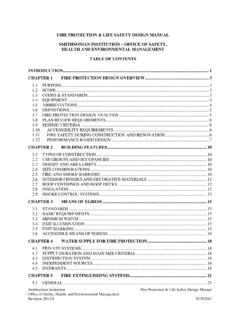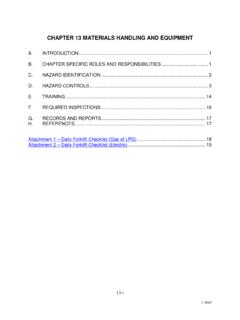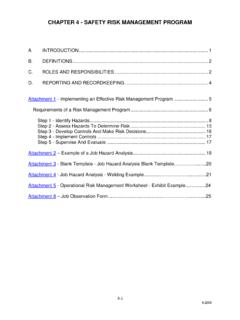Transcription of CHAPTER ## - Draft FIRE SYSTEMS INSPECTION, TESTING …
1 CHAPTER 35 - FIRE SYSTEMS INSPECTION, TESTING , AND MAINTENANCE (ITM) 35 - i A. INTRODUCTION .. 1 B. CHAPTER -SPECIFIC ROLES AND RESPONSIBILITIES .. 1 1. Building Manager .. 1 2. Safety Coordinator .. 1 3. Office of Facilities Management and Reliability (OFMR) .. 2 4. Office of Protection Services (OPS) .. 2 5. Smithsonian Business Ventures, FONZ, and other SI Business Operations .. 3 C. PROGRAM COMPONENTS .. 3 1. Training .. 3 2. Impairments .. 3 3. Required Inspections .. 3 D. RECORDS AND REPORTS .. 3 1. Original Records .. 3 2. ITM Documentation .. 4 3. Information Management 4 4. ITM Report .. 5 E. REFERENCES .. 5 Attachment 1 Automatic Sprinkler Attachment 2 Standpipe and Hose Attachment 3 Private Mains Used for Fire Attachment 4 Fire Attachment 5 Water Storage Tanks Used for Fire Attachment 6 Valves and Fire Department Attachment 7 Kitchen Ventilation Hoods and Fire Suppression Attachment 8 Halon Attachment 9 Clean Agent Fire Extinguishing Attachment 10 Fire Detetion and Alarm Attachment 11 Emergency Generator and Emergency Attachemen 12 Fire Doors and Emergency Attachment 13 Life Safety and Fire Fighters Service on Attachment 14 HVAC and Smoke Management Attachment 15 Portable Fire Attachment 16 Lighting Protection Attachment 17 Paint Spray Attachment 18 NICET 35 - FIRE SYSTEMS INSPECTION, TESTING , AND MAINTENANCE (ITM) 35 - 1 CHAPTER 35 - FIRE SYSTEMS INSPECTION, TESTING AND MAINTENANCE (ITM) A.
2 INTRODUCTION 1. This CHAPTER establishes the Smithsonian Institution (SI) requirements for performing inspections, operational tests, and preventive maintenance on all fire suppression, detection and alarm SYSTEMS , smoke control SYSTEMS , emergency and exit lighting, fire and exit doors, and all other fire protection and life safety SYSTEMS or equipment. 2. The SI relies on fire protection and life safety SYSTEMS in its facilities to provide protection of life and property and to ensure the continuity of important missions established by the Smithsonian. In order to sustain this level of protection, all fire and life safety SYSTEMS must be maintained to ensure high reliability through an effective inspection, TESTING , and preventive maintenance program. 3. Fire protection and life safety SYSTEMS and equipment shall be inspected, tested, and maintained in compliance with the manufacturer s recommendations and the attached appendices.
3 B. CHAPTER -SPECIFIC ROLES AND RESPONSIBILITIES 1. Building Manager a. The building manager shall ensure all required inspections, operational tests and preventative maintenance are performed in accordance with the requirements of this CHAPTER , and all records are distributed to the Safety Coordinator and the Office of Safety, Health and Environmental Management (OSHEM). b. Ensure all fire protection and life safety SYSTEMS protecting leased facilities receive the required inspections, operational tests and preventative maintenance in accordance with this CHAPTER , either through requirements in the lease agreement, or through contracts under SI control. 2. Safety Coordinator a. Verify that all required inspections, operational tests, and preventive maintenance are performed and all records are up to date, in accordance with the ITM requirements of this CHAPTER , through periodic facility inspections and document review.
4 35 - FIRE SYSTEMS INSPECTION, TESTING , AND MAINTENANCE (ITM) 35 - 2 b. Advocate prompt repair of fire protection and life safety SYSTEMS and equipment by tracking deficiencies and ensuring required actions are completed in a timely manner. 3. Office of Facilities Management and Reliability (OFMR) a. Upon notification of a fire protection/life safety system deficiency, the building manager shall ensure that repairs are made promptly in order to restore the system to proper working order. b. The building manager shall retain ITM records for the facility s fire protection and life safety equipment per the requirements of this CHAPTER . c. Perform the required inspections, TESTING and maintenance at specified intervals per the requirements of this CHAPTER , for all fire protection and life safety SYSTEMS and equipment under their responsibility. d. Ensure all fire protection system alterations and additions are properly documented.
5 E. Coordinate all ITM work performed with facility personnel, including scheduling and system impairment. f. Collect and retain ITM information, reports, checklists, and other required records developed during the performance of ITM work. g. Maintain a work order program to prioritize, initiate and track the repair or replacement of all malfunctioning fire protection and life safety system components to ensure SYSTEMS are promptly restored to proper working order in a timely manner. h. Distribute ITM information including schedules, inspection reports and deficiencies to the appropriate facility manager, Safety Coordinator and OSHEM. ITM records shall be distributed within thirty days of the last recorded ITM activity for that period. i. Annually review ITM records and produce a report per the requirements of this CHAPTER . 4. Office of Protection Services (OPS) a. Visually inspect portable fire extinguishers each month for proper mounting and charge per Attachment 15 of this CHAPTER .
6 Initial and date the inspection tag and report missing, undercharged, or defective extinguishers to the building manager and Safety Coordinator. b. Inspect emergency exit doors weekly per Attachment 12 of this CHAPTER to ensure proper operation in the event of an emergency. Immediately notify the building manager and Safety Coordinator of problems that could 35 - FIRE SYSTEMS INSPECTION, TESTING , AND MAINTENANCE (ITM) 35 - 3 hinder egress and ensure they receive the required inspection reports. 5. Smithsonian Business Ventures, FONZ, and other SI Business Operations a. Provide inspection, TESTING , and maintenance for all kitchen exhaust ducts and hoods, and kitchen fire suppression SYSTEMS , per the requirements of this CHAPTER . Submit all records to the building manager and Safety Coordinator within two weeks of the ITM function performed. b. Immediately notify the facility Safety Coordinator of any malfunction or code violation related to fire equipment within their space or affecting their operations.
7 C. Cease cooking operations while kitchen fire suppression SYSTEMS are impaired, and ensure the impairment process has been initiated per CHAPTER 36, Fire Protection , of this Manual. d. Upon notification of a fire protection/life safety system deficiency, ensure repairs are made promptly in order to restore the system to proper working order. C. PROGRAM COMPONENTS 1. Training. ITM tasks shall be performed by personnel trained/qualified in the maintenance and repair of the subject fire protection system or equipment. These personnel shall have available the manufacturer s service installation Manuals, maintenance Manuals, and service bulletins for the system or equipment being installed. 2. Impairments. All planned impairments of fire protection or life safety SYSTEMS must be conducted in accordance with the precautions outlined in the CHAPTER 36, Fire Protection , of this Manual. 3. Required Inspections, TESTING and Maintenance.
8 All fire protection/life safety SYSTEMS and equipment shall be inspected, tested, and maintained in accordance with the requirements outlined in Attachments 1-17 of this CHAPTER . D. RECORDS AND REPORTS. Two types of records are essential for the long term care of fire protection/life safety SYSTEMS and equipment: the original records and periodic inspection, TESTING , and maintenance documentation. 1. Original Records. As of October 2007, original records of exiting fire protection / life safety SYSTEMS where available and for all new SYSTEMS shall be retained for the life of the system. OFMR shall also retain a copy of 35 - FIRE SYSTEMS INSPECTION, TESTING , AND MAINTENANCE (ITM) 35 - 4 original records. Original records consist of the following: a. Date of installation ; b. As-built drawings; c. Operation and maintenance manuals; d. Installer information (business address and telephone number); e. Designation of equipment types and inventory of devices; f.
9 Equipment and system settings; g. Equipment data sheets 2. ITM Documentation. Inspection, TESTING , and Maintenance (ITM) documentation shall be retained for a minimum of 10 years for items that require annual or less frequent ITM. ITM documentation for items with frequencies greater than 1 year shall be retained for the life of the system. This documentation shall be retained by the facility manager. In addition, the OFMR units(s) responsible for ITM shall retain ITM records for all SYSTEMS under its care. These records shall include all of the following information: a. Date; b. Procedure performed; c. Name and signature of the servicing personnel and the organization s name that performed the work; d. Test results; e. Equipment and system deficiencies f. Corrective actions, including parts replaced and settings or programming changes 3. Information Management System. OFMR shall establish and maintain an information management system for ITM documentation of all fire alarm, detection, suppression, smoke control and fire smoke damper and equipment under their care.
10 The system shall provide the following: a. An electronic database with retrievable historical records for each piece of equipment, group of similar pieces of equipment, or system; b. Schedules for the scope and frequency of inspection and service for all equipment; c. A method of persistent follow-up to ensure that inspection, TESTING , and 35 - FIRE SYSTEMS INSPECTION, TESTING , AND MAINTENANCE (ITM) 35 - 5 maintenance services are being performed according to schedule; d. A method of assigning priorities to equipment repair and maintenance tasks; e. Specifications for special replacement parts and materials. A list of qualified suppliers for these items should be available by cross-reference; 4. ITM Report (fire alarm, detection, suppression, smoke control and fire smoke damper) a. OFMR shall annually review the ITM data collected for facilities and generate a report which examines trends ( failure rates, system aging) and identifies specific problems.






